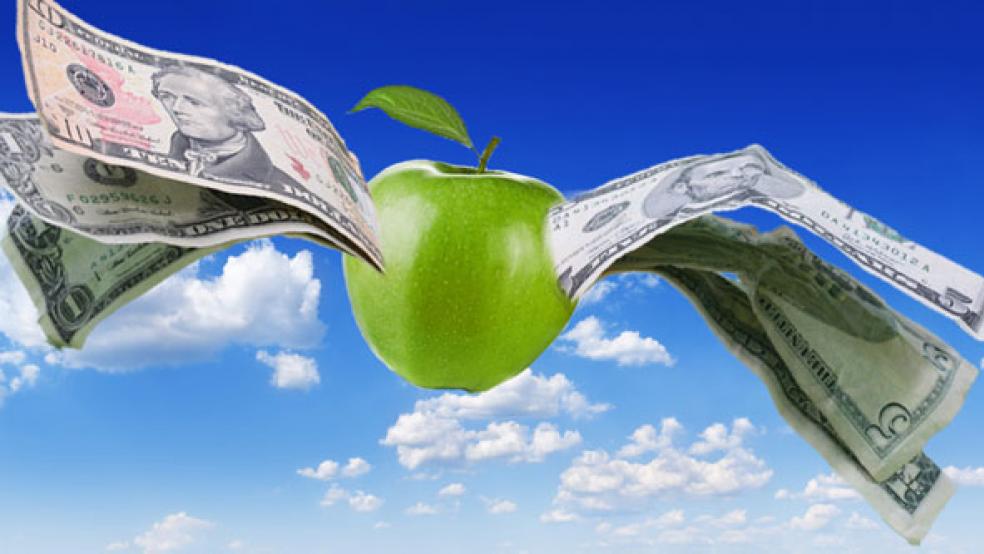Apple’s fourth-quarter earnings, out today, put the punctuation—an exclamation point, naturally!—on another remarkable year for the tech giant. Apple’s fiscal 2011 was its best year ever. The company now has three hit product lines—the iPhone, iPad, and Mac computers—that are posting solid or even explosive sales growth, and a fourth, the iPod, that still generates billions in sales even as it fades. Those blockbuster successes are forcing Wall Street analysts to scramble to keep up. Just three months ago, the Street’s consensus estimate for earnings per share was $6.48. Today it’s $7.33, or nearly 60 percent higher than the $4.64 Apple posted for the same period last year. Apple’s annual revenues have surged to around $30 billion, up from $20.34 billion for the fourth quarter of 2010. And Apple’s stock price, which closed yesterday just under $420, has made it the most valuable company in the world, with a market capitalization now approaching $400 billion.
The iPhone in particular has become a force felt across the technology and media landscape. And despite some initial disappointment among gadget freaks and tech-industry talking heads at the announcement of the iPhone 4S earlier this month, the new release still garnered a record 1 million pre-sales, with customers buying more than 4 million of the phones in just the three days following its release. After waiting 16 months for Apple’s new phone, customers are still lining up today to get their hands on the 4S, and analysts say Apple could sell 100 million in the coming year.
That success caps a comeback that began after Steve Jobs returned for a second stint as Apple’s CEO in the mid-1990s and ushered in an era of candy-colored all-in-one iMacs—and, in a turnaround for Apple, solid profitability. But Apple’s resurgence kicked into high gear almost exactly 10 years ago—on October 23, 2001, when Jobs announced the iPod. It was the iPod, along with the iTunes music store, that launched the Apple revolution, empowering Apple to set its stamp on media, upend tech companies’ typical relationships with vendors, and transform consumer expectations and behavior.
“ Apple taught consumers how to pay for media -- and to expect to pay for media”
As the remembrances of Jobs, who died October 5, have often noted, Apple and its iconic CEO changed the way we live and play. For years tech experts debated how or whether consumers would pay for content in the Internet Age. Apple answered that question almost singlehandedly when it launched its iTunes Store, where users now download billions of dollars worth of music, movies, TV shows, and books via more than 225 million iTunes accounts. “One of the big innovations that came from the iTunes store is that Apple taught consumers how to pay for media -- and to expect to pay for media,” says Carl Howe of technology researcher Yankee Group.
The company launched what was originally called the iTunes Music Store in April 2003, about a year and a half after it rolled out its first iPod. Since then, Apple has sold more than 16 billion songs and become the country’s largest music retailer. While the availability of hundreds of thousands of apps has helped, and in turn been helped by, the wide adoption of the iPhone and subsequently the iPad, the mobile revolution set into high gear with the rollout of the iPhone has only added to the exploding demand for mobile media—though Apple itself still doesn’t make huge profits from the iTunes store.
Apple splits the revenue from sales of media and apps through iTunes, keeping 30 percent and sending 70 percent to the publishers of the content. The company doesn’t detail iTunes sales in its earnings reports, but it has often said that the store runs only a bit above break even, with its main purpose being to increase the appeal of Apple’s hardware. Or as independent Apple analyst Robert Paul Leitau puts it: “Content sells devices.”
That profit picture could still change, as the iTunes business continues to scale and customers buy more expensive apps and videos rather than $1.29 songs. The iTunes platform, according to recent projections by Global Equities Research, will generate $13 billion in revenues by 2013.
With that kind of demand for mobile data and content, competitors—most notably Amazon, but also Google, Netflix, and others—are gunning to take a slice out of Apple. While Apple looks at content as a way to sell more hardware, Amazon looks at hardware as a way to sell more content. Amazon’s new Kindle Fire tablet, for example, is meant—and priced—to undercut the iPad and have consumers go through Amazon to get their content. As the markets for streaming video, music, and even online periodicals develop, the competition is bound to ratchet even higher. So Apple, for all it has achieved, must push to innovate yet again.




